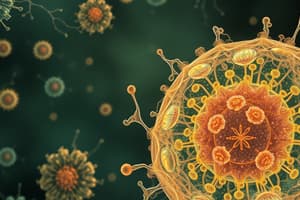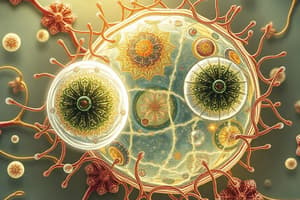Podcast
Questions and Answers
Which of the following is NOT a main point of cell theory?
Which of the following is NOT a main point of cell theory?
- Cells are the basic units of structure and function
- New cells arise from chemical compounds (correct)
- New cells are produced from existing cells
- All living things are composed of cells
Electron microscopes can see objects in color.
Electron microscopes can see objects in color.
False (B)
What distinguishes prokaryotic cells from eukaryotic cells?
What distinguishes prokaryotic cells from eukaryotic cells?
Prokaryotic cells do not have a nucleus, whereas eukaryotic cells do.
The __________ contains nearly all the cell's DNA.
The __________ contains nearly all the cell's DNA.
Match the following organelles with their functions:
Match the following organelles with their functions:
What type of microscope would you use to observe the detailed structure of a mitochondrion?
What type of microscope would you use to observe the detailed structure of a mitochondrion?
Proteins are assembled in the Golgi apparatus.
Proteins are assembled in the Golgi apparatus.
What are the two organelles involved in the making and transporting of proteins?
What are the two organelles involved in the making and transporting of proteins?
What structure is primarily responsible for maintaining homeostasis in multicellular organisms?
What structure is primarily responsible for maintaining homeostasis in multicellular organisms?
Cells in multicellular organisms communicate exclusively through electrical signals.
Cells in multicellular organisms communicate exclusively through electrical signals.
What are the levels of organization in a multicellular organism?
What are the levels of organization in a multicellular organism?
All living things, except viruses, are made up of _____
All living things, except viruses, are made up of _____
Match the type of cell to its characteristic:
Match the type of cell to its characteristic:
What is a key reason for using the metric system in scientific measurements?
What is a key reason for using the metric system in scientific measurements?
Ribosomes are found only in eukaryotic cells.
Ribosomes are found only in eukaryotic cells.
What type of muscle contracts without conscious thought?
What type of muscle contracts without conscious thought?
Which organelles are primarily responsible for energy transformation in plant cells?
Which organelles are primarily responsible for energy transformation in plant cells?
Mitochondria are referred to as the powerhouses of the cell because they release energy through photosynthesis.
Mitochondria are referred to as the powerhouses of the cell because they release energy through photosynthesis.
What is the main function of ribosomes in a cell?
What is the main function of ribosomes in a cell?
The _____ is considered the control center of the cell, directing activities and housing genetic material.
The _____ is considered the control center of the cell, directing activities and housing genetic material.
Match the organelles with their primary functions:
Match the organelles with their primary functions:
Which of the following best describes the rough endoplasmic reticulum?
Which of the following best describes the rough endoplasmic reticulum?
Plant cells only require chloroplasts for their energy needs.
Plant cells only require chloroplasts for their energy needs.
What is the function of vacuoles in a cell?
What is the function of vacuoles in a cell?
Flashcards
Protein Assembly Location
Protein Assembly Location
Proteins destined for the cell membrane or internal locations are made on ribosomes attached to the rough endoplasmic reticulum.
Protein Transport
Protein Transport
Newly assembled proteins move from the rough endoplasmic reticulum to the Golgi apparatus in small sacs called vesicles.
Golgi Apparatus Function
Golgi Apparatus Function
The Golgi modifies and packages proteins, then sends them to their final destinations within or outside of the cell.
Mitochondria's Role
Mitochondria's Role
Signup and view all the flashcards
Protein Factory
Protein Factory
Signup and view all the flashcards
Plant Cell Energy Needs
Plant Cell Energy Needs
Signup and view all the flashcards
Cellular Control Center
Cellular Control Center
Signup and view all the flashcards
Organelles for Storing, Cleaning, Supporting
Organelles for Storing, Cleaning, Supporting
Signup and view all the flashcards
Cell Theory Main Points
Cell Theory Main Points
Signup and view all the flashcards
Microscope Function
Microscope Function
Signup and view all the flashcards
Hooke's Cell Discovery
Hooke's Cell Discovery
Signup and view all the flashcards
False Colored Micrographs
False Colored Micrographs
Signup and view all the flashcards
Prokaryote vs. Eukaryote
Prokaryote vs. Eukaryote
Signup and view all the flashcards
Eukaryotic Cell Organisms
Eukaryotic Cell Organisms
Signup and view all the flashcards
Basic Unit of Life
Basic Unit of Life
Signup and view all the flashcards
New Cell Production
New Cell Production
Signup and view all the flashcards
Hypertonic Cell
Hypertonic Cell
Signup and view all the flashcards
Homeostasis in Unicellular Organisms
Homeostasis in Unicellular Organisms
Signup and view all the flashcards
Cell Specialization in Multicellular Organisms
Cell Specialization in Multicellular Organisms
Signup and view all the flashcards
Levels of Organization in Multicellular Organisms
Levels of Organization in Multicellular Organisms
Signup and view all the flashcards
Cell Communication in Multicellular Organisms
Cell Communication in Multicellular Organisms
Signup and view all the flashcards
What are all living things made of?
What are all living things made of?
Signup and view all the flashcards
Micrometer Size
Micrometer Size
Signup and view all the flashcards
Prokaryotic Cell Example
Prokaryotic Cell Example
Signup and view all the flashcards
Study Notes
8.1 Life Is Cellular
- All living things come from cells
- Cells are the basic units of structure and function in living things
- New cells are produced from existing cells
- Microscopes use multiple lenses to magnify small objects
- Hooke saw cork chambers and named them cells
- Micrographs' false colors are computer-created to highlight features
- Prokaryotic cells are smaller and simpler than eukaryotic cells, and do not have a nucleus
- Eukaryotic cells have a nucleus that encloses genetic material
- Protists, plants, animals, and fungi have eukaryotic cells
How do Microscopes Work?
- Microscopes use multiple lenses to magnify small objects
How did Hooke's work contribute to cell theory?
- Hooke saw cork cells and named them cells
What does it mean if a micrograph is false colored?
- Computer adds colors to highlight details; electron microscopes usually show black and white images
What are the defining characteristics of prokaryotic and eukaryotic cells?
- Prokaryotic cells are simpler and smaller, and lack a nucleus
- Eukaryotic cells are larger, more complex, and contain a nucleus
What types of organisms have eukaryotic cells?
- Protists, plants, animals, and fungi
What is the basic concept of biology that includes the idea that new cells can be produced only by the division of existing cells?
- Cell theory
If you wanted to observe the detailed structure of a mitochondrion, which type of microscope would you use?
- Light Microscope
8.2 Cell Structure
- Endoplasmic Reticulum (ER) and Golgi Apparatus make and transport proteins
- Rough ER sends proteins to the Golgi Apparatus
- Vacuoles store materials (water, salts, proteins, carbohydrates)
- Lysosomes break down lipids, carbohydrates, and proteins
- Proteins are assembled on ribosomes
- Newly assembled proteins travel to the rough ER and complete assembly there.
- Golgi apparatus modifies, sorts, and packages proteins in vesicles
- Vesicles transport proteins to their final destinations
- Chloroplasts and mitochondria work together to provide energy in plants
- Ribosomes assemble proteins
- Mitochondria are known as the powerhouses of the cell because they release energy through cellular respiration
- The nucleus is the control center of the cell that contains DNA and instructions for proteins
- The endoplasmic reticulum produces proteins for the cell to function
- Vesicles store, clean up, and support
- Mitochondria and chloroplasts capture and release energy
- Cells maintain integrity with a cell membrane
8.3 Cell Transport
- In passive transport, substances move from high to low concentration without energy
- Gradient, particle size, and temperature affect diffusion rate
- Active transport moves substances against the concentration gradient, requiring energy (ATP)
- Two types of diffusion are simple and facilitated. Facilitated diffusion uses proteins to help substances move across the membrane
8.4 Homeostasis and Cells
- Unicellular organisms grow, respond, transform energy, and reproduce to maintain homeostasis
- Multicellular cells become specialized for different tasks and communicate to maintain homeostasis.
- Specialization of cells helps maintain homeostasis in multicellular organisms
(Additional Topic): Levels of Organization in Multicellular Organisms
- Cells combine to form tissues
- Tissues combine to form organs,
- Organs combine to form organ systems
Studying That Suits You
Use AI to generate personalized quizzes and flashcards to suit your learning preferences.
Related Documents
Description
Explore the fundamental concepts of cellular biology in this quiz. Learn about cell theory, the differences between prokaryotic and eukaryotic cells, and the role of microscopes in studying cells. Perfect for reinforcing your understanding of the basic units of life.




